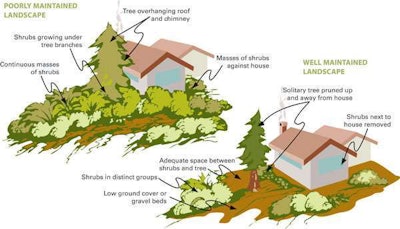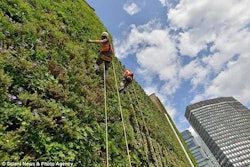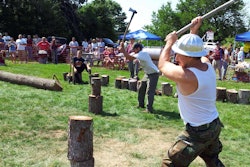 Utah State University Cooperative Extension
Utah State University Cooperative ExtensionWildfire season is far from over, and the pressure is on for several states to try and protect more homes and businesses from burning.
A glimpse of hope came when a few Utahns’ homes were saved from proper landscaping, according to The Salt Lake Tribune.
Homeowners who did fire-mitigation landscaping did not lose their homes in the Rockport 5 Fire recently.
Utah adopted the national wildland fire mitigation program in 2006, which requires a 30-foot zone of brush and trees cleared around a structure.
A second zone of 30 to 100 feet should be thinned of heavy brush and woods, the program states.
The Utah State University Extension Office has provided tips on how to create a fire-resistant landscape.
- Cut tall grass near structures.
- Remove excess brush and small trees from at least 30 feet around buildings. Dense brush burns quickly and can provide a “ladder” for low flames to reach up into larger trees.
- On larger lots, maintain a fuel break of low-growing plants 30 to 70 feet out from buildings. Such fuel breaks act as a buffer between the manicured landscape near the home and the adjacent wildlands.
- Rake up leaves and twigs. Remove plant litter (dead leaves, twigs, etc.) that accumulates under trees and shrubs to reduce fuel loads. Removed litter should be placed in an approved landfill. It should not be piled on the property or in adjacent woodlands.
- Prune tree branches. Prune branches up to ten to 20 feet above the ground on large trees to prevent low fires from reaching the tree crowns.
- Thin dense tree groups. Though the grouping of trees is normally a good landscaping technique, in fire-prone areas it can be hazardous. Thinning these groups will slow the spread of fire.
- Place fences, trees, retaining walls, etc. so that they don’t restrict firefighting equipment access.
- Choose landscape plants that are less flammable. All plants will burn if a fire is severe enough. Some plants are more fire-prone than others, however. Conifers such as pines and spruces tend to be fairly flammable, while many broadleaved trees are fairly fire resistant.
- A thirty foot wide clear space around a home may not be adequate in a severe fire, especially if neighboring properties have not been well-designed or maintained. Neighbors should cooperate to reduce fire risk by having good defensible spaces that join one another.
- Maintenance is a never-ending task. Inspect landscapes monthly and attend to problem situations before they become serious hazards.










